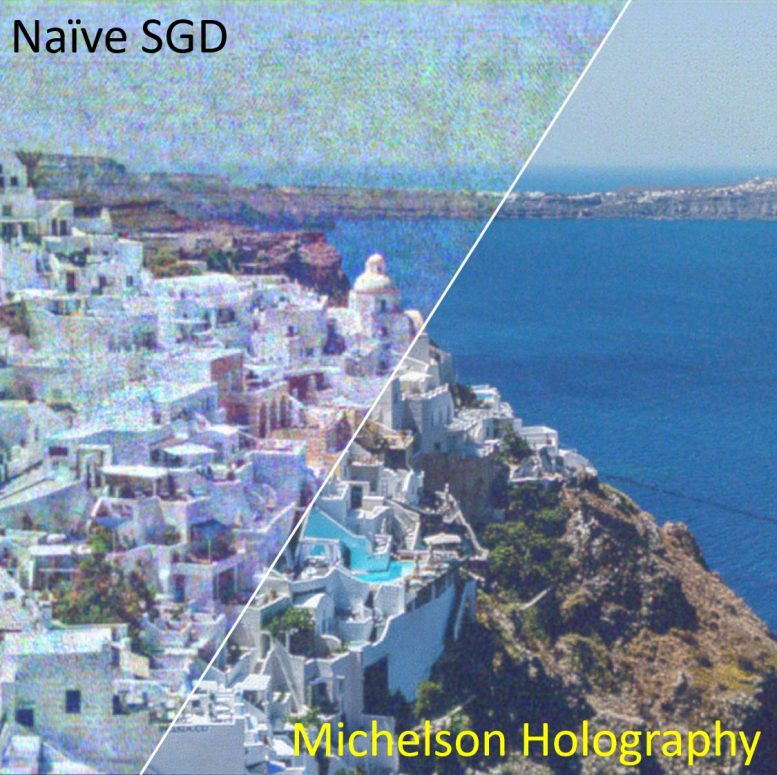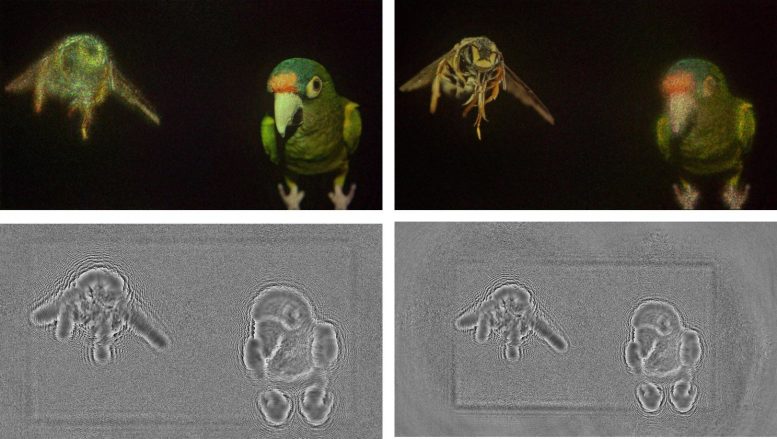
Michelson holography shows significant improvements in image quality, contrast, and speckle reduction compared with all other conventional methods, such as Naïve SGD. Credit: Jonghyun Kim, Nvidia, Stanford University
Advances in both software and hardware could make holography viable for more applications.
Researchers have developed a new approach that improves the image quality and contrast for holographic displays. The new technology could help improve near-eye displays used for virtual and augmented reality applications.
“Augmented and virtual reality systems are poised to have a transformative impact on our society by providing a seamless interface between a user and the digital world,” said research team member Jonghyun Kim from technology company NVIDIA and Stanford University. “Holographic displays could overcome some of the biggest remaining challenges for these systems by improving the user experience and enabling more compact devices.”
In Optica, The Optical Society’s (OSA) journal for high impact research, the researchers describe their new holography display technology called Michelson holography. The approach combines a new optical setup inspired by Michelson interferometry with a recent software development. The setup generates the interference patterns necessary for making digital holograms.
The undiffracted light from two SLMs naturally creates a fringe pattern. The camera-in-the-loop algorithm iteratively optimizes both phase patterns to create the target image. Credit: Jonghyun Kim, Nvidia, Stanford University
“Although we’ve recently seen tremendous progress in machine-learning driven computer-generated holography, these algorithms are fundamentally limited by the underlying hardware,” said Kim. “We co-designed a new hardware configuration and a new algorithm to overcome some of these limitations and demonstrate state-of-the-art results.”
Boosting quality Holographic displays have the potential to outperform other 3D display technologies used for virtual and augmented reality by enabling more compact displays, improving the user’s ability to focus their eyes at different distances and offering the ability to adjust for users who wear corrective lenses. However, the technology hasn’t yet achieved the image quality of more conventional technologies.
For holographic displays, image quality is limited by an optical component known as a phase-only spatial light modulator (SLM). SLMs create the diffracted light that makes the interference pattern needed to form visible 3D images. However, the phase-only SLMs typically used for holography exhibit a low diffraction efficiency that significantly degrades observed image quality, especially image contrast.

The researchers used a camera-in-the-loop optimization process to improve the holographic images. The top images show the captured near and far plane focal images acquired with the optimization process while the bottom images show the two phase images used to create the hologram. Credit: Jonghyun Kim, Nvidia, Stanford University
Because it is difficult to dramatically increase the diffraction efficiency of SLMs, the researchers designed a completely new optical architecture to create holographic images. Rather than using a single phase-only SLM like most setups, their Michelson holography approach uses two phase-only SLMs.
“The core idea of Michelson holography is to destructively interfere with the diffracted light of one SLM using the undiffracted light of the other,” said Kim. “This allows the undiffracted light to contribute to forming the image rather than creating speckle and other artifacts.”
Optimizing the image The researchers combined this new hardware arrangement with a camera-in-the-loop (CITL) optimization procedure they modified for their optical setup. CITL optimization is a computational approach that can be used to optimize a hologram directly or to train a computer model based on a neural network.
CITL allowed the researchers to use a camera to capture a series of displayed images. This meant they could correct small misalignments of the optical system without using any precise measuring devices.
“Once the computer model is trained, it can be used to precisely figure out what a captured image would look like without physically capturing it,” said Kim. “This means that the entire optical setup can be simulated in the cloud to perform real-time inference of computationally heavy problems with parallel computing. This could be useful for calculating a computer-generated hologram for a complicated 3D scene, for example.”
The researchers tested their new Michelson holography architecture using a benchtop optical setup in their lab. They used it to display several 2D and 3D holographic images, which were recorded with a conventional camera. The demonstration showed that the dual-SLM holographic display with CITL calibration provides significantly better image quality than existing computer-generated hologram approaches.
Making the new system practical would require translating the benchtop setup into a system that would be small enough to incorporate into a wearable augmented or virtual reality system. The researchers point out that their approach of co-designing hardware and software could be useful for improving other applications of computational displays and computational imaging in general.
Reference: “Michelson Holography: Dual-SLM Holography with Camera-in-the-loop Optimization” by Suyeon Choi, Jonghyun Kim, Yifan Peng, and Gordon Wetzstein, 28 January 2021, Optica.DOI: 10.